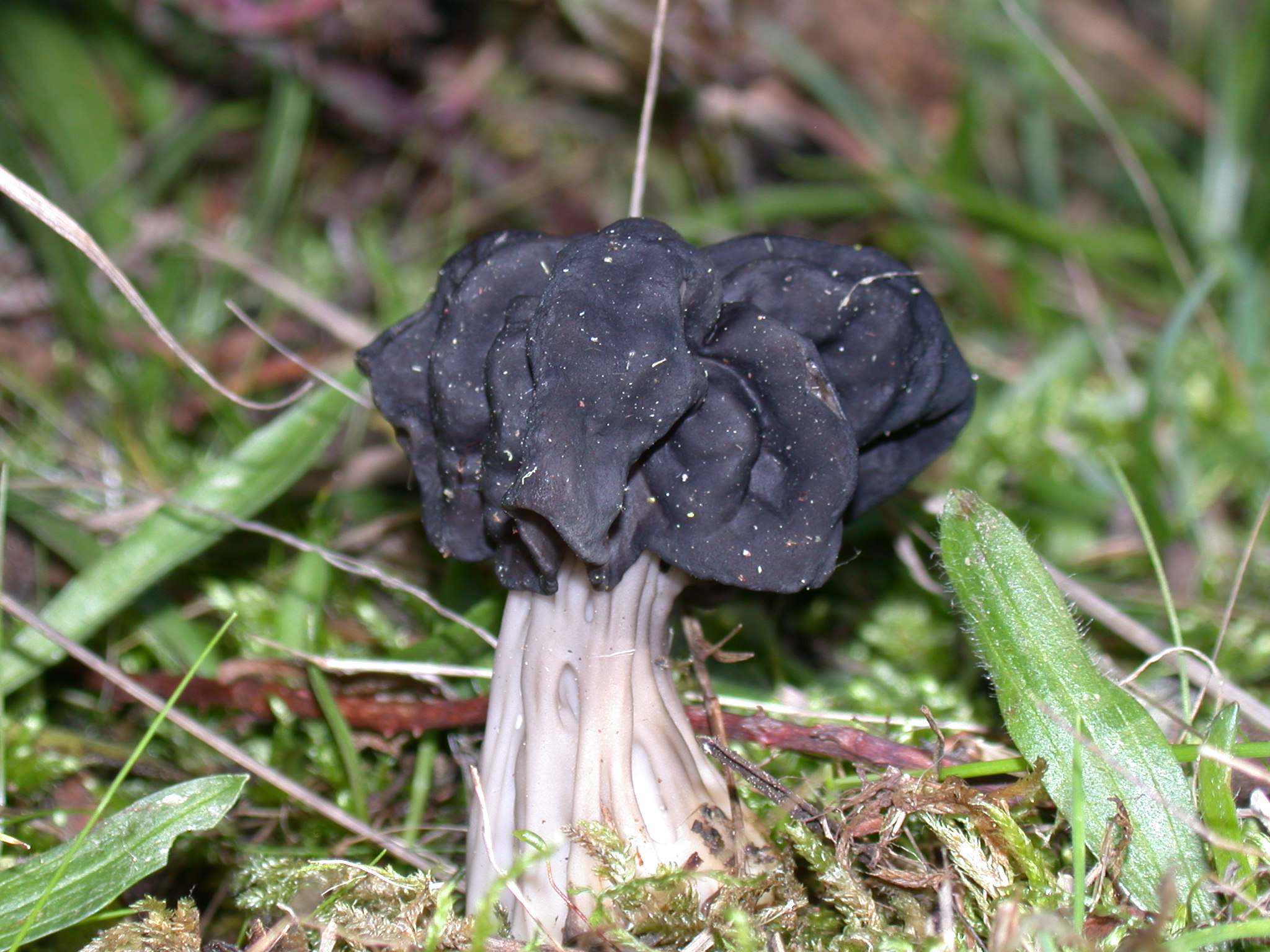- Helvella lacunosa
Taxobox
name = "Helvella lacunosa"

image_width = 250px
image_caption =
regnum =Fungi
divisio =Ascomycota
subdivisio =Pezizomycotina
classis =Pezizomycetes
ordo =Pezizales
familia =Helvellaceae
genus = "Helvella "
species = "H. lacunosa"
binomial = "Helvella lacunosa"
binomial_authority = (Afzel.)mycomorphbox
name = Helvella crispa
hymeniumType=smooth
capShape = convex
whichGills = NA
stipeCharacter=bare
sporePrintColor=white
ecologicalType=saprotrophic
ecologicalType2=mycorrhizal
howEdible2=poisonous
howEdible=edibleProbably the most common "Helvella" species.cite book | author = Thomas Laessoe | year = 1998 | title = Mushrooms (flexi bound) | Publisher = Dorling Kindersley | isbn = 0-7513-1070-0] "Helvella lacunosa", also known as the slate grey saddle or fluted black elfin saddle, is an ascomycetefungus of theHelvellaceae family. Themushroom is readily identified by its irregularly shaped grey cap, fluted stem, and fuzzy undersurfaces. It is found in western North America and in Europe, near deciduous and coniferous trees in summer and autumn.Taxonomy
The fungus was originally described by the naturalist
Adam Afzelius in 1783. Its specific epithet isLatin adjective "lacunosa" 'with holes'. The generic name was originally a type of Italian herb but became associated with morels.Nilsson S, Persson O.(1977) "Fungi of Northern Europe 1: Larger Fungi (Excluding Gill Fungi)". pp. 36-37. Penguin Books. isbn 0-14-063-005-8] "H. sulcata"; once separated, because of certain differences in the lobe structure is now dropped, or just a synonym. It was not possible to draw a clear distinction between the two.cite book | author = Marcel Bon | year = 1987 | title = The Mushrooms and Toadstools of Britain and North Western Europe | publisher = Hodder and Stoughton | isbn = 0 340 39935 X]Description
"Helvella lacunosa" has a irregularly folded or wrinkled cap which may be shades of slatey grey to black in colour, and measure anywhere from 1 to 10 cm (½-4 in), though usually between 2 and 5 cm (1-2 in). The wrinkled ringless 3-15 cm (1-6 in) high stem is chambered within, and may be white when young and darker with age, though may be any shade of grey. The
spore print is white, the oval spores average 12 x 9 μm.cite book |last=Arora |first=David|authorlink=David Arora |year=1986 |title=Mushrooms demystified: a comprehensive guide to the fleshy fungi |edition=2nd ed. |location=Berkeley |publisher=Ten Speed Press |isbn=0-89815-169-4| pages=pp. 815-16] Occasionally white capped forms are found. They may be distinguished from the creamy-white coloured "Helvella crispa " by the latter's furry cap undersurface and inrolled margins when young.Distribution and habitat
This species is common in western North America and is also found in Europe. It is frequent in the
alpine , and temperate zones of both the northern and southern hemispheres. Occurring under pine, oak and Douglas fir and nearby parkland and lawns. Fruiting bodies appear in late summer and autumn, though have been recorded in winter in California. It often occurs on burnt ground.cite book | author = Phillips R | year = 2006 | title = Mushrooms |pages=p. 360| publisher = Pan Macmillan Ltd|location=London| isbn=0-330-44237-6]Some specimens have a white moldy appearance, having been colonised by the parasitic
Ascomycete fungus "Hypomyces cervinigenus ".Edibility
This species is eaten and regarded highly by some after cooking, though the stems are not eaten. Several guidebooks list it as edible,cite book | last = Haas |first=Hans | year = 1969 | title = The Young Specialist looks at Fungi |pages=p. 184| publisher = Burke | isbn= 0-222-79409-7] yet this genus is now regarded with suspicion due to the presence of toxic compounds in several related species. It has been reported to cause gastrointestinal symptoms when eaten raw.cite book |last=Ammirati |first=Joseph F.|coauthors= James A Traquair and Paul A Horgen |title=Poisonous mushrooms of the northern United States and Canada |year=1985 |publisher=University of Minnesota Press |location=Minneapolis |isbn=0-8166-1407-5 |pages=p. 259]
References
Wikimedia Foundation. 2010.
